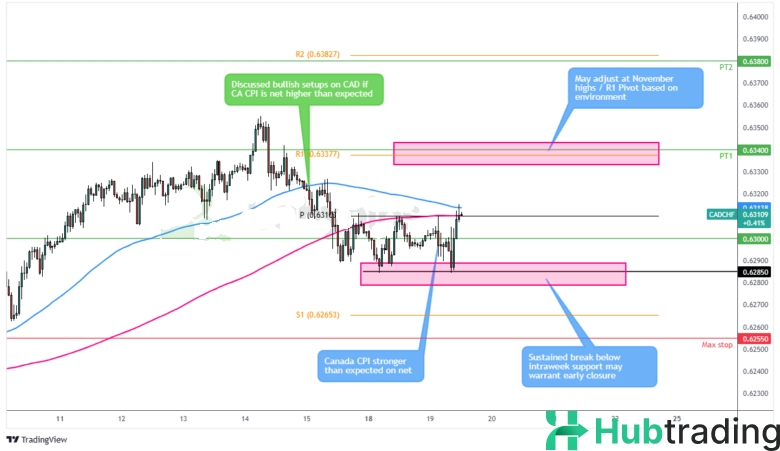Today's stronger-than-anticipated Canadian CPI data suggests potential short-term upside for CAD/CHF.
Headline inflation surged to 2.0%, surpassing the 1.9% forecast, while core inflation measures also showed unexpected strength. This reduces the likelihood of another Bank of Canada (BOC) rate cut in December, shifting market sentiment in favor of the Canadian Dollar.
Here’s a theoretical approach to structuring a trade plan around this development.
Why Do Sellers Currently Have an Edge Over Buyers in CAD/CHF?
The latest Canadian CPI data surpassed expectations across key metrics:
- Headline CPI: Increased to 2.0% vs. 1.9% forecast.
- Core Inflation Measures: Trimmed and median CPI reached 2.6% and 2.5%, exceeding the 2.4% forecast.
- Monthly CPI Figures: Indicated stronger-than-expected price pressures.
This inflation surprise is likely to:
- Reduce market expectations for aggressive Bank of Canada (BOC) rate cuts in December.
- Strengthen the Canadian dollar against currencies from regions with more dovish central banks.
- Keep CAD decoupled from oil price fluctuations, focusing instead on interest rate differentials.
Key Upcoming Events Impacting CAD/CHF:
- Federal Reserve Commentary: Multiple Fed speakers this week could influence rate expectations and risk sentiment.
- Global Flash PMIs (Friday): Potentially significant for overall market risk appetite.
- CHF Dynamics: Ongoing European growth concerns could keep the Swiss Franc under pressure.
A consolidation or pullback in risk assets amid Fed commentary may offer better entry points for CAD longs.
Trade Structure Based on Price Action & Technical Analysis
CAD/CHF 1-Hour Outlook

- Expected Range: 0.6275 – 0.6350 (based on current ATR of ~40 pips).
- Key Technical Zone: Consolidation between 0.6285 – 0.6310 may attract buyers.
- Entry Opportunity: Near 0.6300, aligning with the 61.8% Fibonacci retracement and recent support.
Proposed Trade Setup
The entry strategy involves placing a limit order to buy CAD/CHF at 0.6300. This level is strategically chosen as it offers a favorable risk-reward potential, taking into account both technical and fundamental factors.
For the loss adjustment and exit strategy, a hard stop is set at 0.6255, corresponding to a maximum loss of 45 pips (approximately one ATR). This provides adequate room for market volatility, representing a -1R risk. Additionally, a conditional soft stop is set at 0.6280, just 20 pips below the entry point. If the price falls below this recent support level, the trade will be reassessed for an early exit, with a potential loss of ~-0.44R. A broader risk assessment will also be conducted, and the position may be closed prematurely if the overall risk environment worsens or if hawkish commentary from the Federal Reserve affects market sentiment.
The profit targets are defined to capitalize on key resistance levels. The first target is set at 0.6340, which aligns with previous resistance, offering a 0.80:1 risk-reward ratio from the hard stop or 2.0:1 from the soft stop. The second target is placed at 0.6380, corresponding to monthly highs, with a 1.60:1 risk-reward ratio from the hard stop or 4.0:1 from the soft stop. Upon reaching the first target at 0.6340, the market environment will be reassessed to determine whether partial profits should be taken, stops adjusted, or targets revised.
An end-of-week review will be conducted to evaluate the trade’s performance and viability. Based on the prevailing market dynamics, Federal Reserve commentary, and overall risk sentiment, a decision will be made on whether to hold, adjust, or exit the position. This comprehensive approach ensures that the trade remains aligned with evolving market conditions while managing risk effectively.





